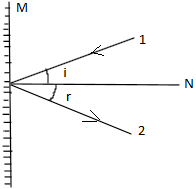
Answer
110.4k+ views
Hint: The angle of incidence and the angle of reflection are both calculated with respect to the normal drawn to that surface and not with respect to the plane of the surface itself. Also, the angle of incidence is equal to the angle of reflection irrespective of the shape of the reflecting surface.
Complete Step by step solution:
By the law of reflection, it is said that the angle of incidence and the angle of reflection for any ray of light, reflecting off of a surface will always be equal, irrespective of the surface being plane as in the case of plane mirror or curved as in the case of concave and convex mirrors or even in the case of arbitrarily shaped reflecting surfaces. As such the formula is given which is $\angle i = \angle r$where ‘i’ is the angle of incidence or the angle at which the light ray strikes the surface and ‘ r’ is the angle of reflection or the angle at which the reflected ray leaves the surface.
One thing which should be kept in mind is that these angles of incidence and reflection are always measured from the normal to the surface.

The diagram shown above is an instance of reflection. Here ‘N’ is the normal to the reflecting surface ‘M’. ‘1’ shown here is the ray of incidence which forms $\angle i$ with ‘N’ and ‘2’ is the reflected ray which leaves at $\angle r$ with ‘N’. Here $\angle i$ and $\angle r$ will both be equal due to the law of reflection.
As for the question above, the incident ray falls on the surface normally which means that ray ‘1’ will coincide with ‘N’ and as such, will make an angle of ${0^ \circ }$with the same. Thus, by the law of reflection, the reflecting ray that is ray ‘2’ will also make the same angle with the normal which is ${0^ \circ }$ and that ray too will coincide with the normal.
Note:
In case of the curved surfaces such as concave and convex reflecting surfaces or in case of arbitrarily shaped reflecting surfaces, first thing that needs to be done is to plot the tangent at the point of reflection and then perpendicular to the tangent, a normal must be drawn before plotting incidence and reflection rays and angles.
Complete Step by step solution:
By the law of reflection, it is said that the angle of incidence and the angle of reflection for any ray of light, reflecting off of a surface will always be equal, irrespective of the surface being plane as in the case of plane mirror or curved as in the case of concave and convex mirrors or even in the case of arbitrarily shaped reflecting surfaces. As such the formula is given which is $\angle i = \angle r$where ‘i’ is the angle of incidence or the angle at which the light ray strikes the surface and ‘ r’ is the angle of reflection or the angle at which the reflected ray leaves the surface.
One thing which should be kept in mind is that these angles of incidence and reflection are always measured from the normal to the surface.

The diagram shown above is an instance of reflection. Here ‘N’ is the normal to the reflecting surface ‘M’. ‘1’ shown here is the ray of incidence which forms $\angle i$ with ‘N’ and ‘2’ is the reflected ray which leaves at $\angle r$ with ‘N’. Here $\angle i$ and $\angle r$ will both be equal due to the law of reflection.
As for the question above, the incident ray falls on the surface normally which means that ray ‘1’ will coincide with ‘N’ and as such, will make an angle of ${0^ \circ }$with the same. Thus, by the law of reflection, the reflecting ray that is ray ‘2’ will also make the same angle with the normal which is ${0^ \circ }$ and that ray too will coincide with the normal.
Note:
In case of the curved surfaces such as concave and convex reflecting surfaces or in case of arbitrarily shaped reflecting surfaces, first thing that needs to be done is to plot the tangent at the point of reflection and then perpendicular to the tangent, a normal must be drawn before plotting incidence and reflection rays and angles.
Recently Updated Pages
Write an article on the need and importance of sports class 10 english JEE_Main

Write a composition in approximately 450 500 words class 10 english JEE_Main

Arrange the sentences P Q R between S1 and S5 such class 10 english JEE_Main

If x2 hx 21 0x2 3hx + 35 0h 0 has a common root then class 10 maths JEE_Main

The radius of a sector is 12 cm and the angle is 120circ class 10 maths JEE_Main

For what value of x function fleft x right x4 4x3 + class 10 maths JEE_Main

Other Pages
Electric field due to uniformly charged sphere class 12 physics JEE_Main

If a wire of resistance R is stretched to double of class 12 physics JEE_Main

In Searles apparatus when the experimental wire is class 11 physics JEE_Main

The energy stored is a condenser is in the form of class 12 physics JEE_Main

Excluding stoppages the speed of a bus is 54 kmph and class 11 maths JEE_Main




